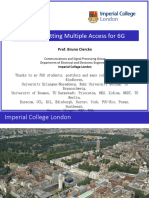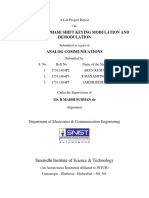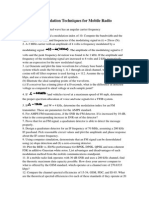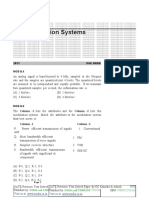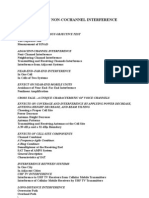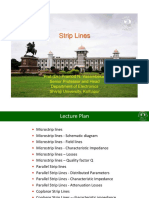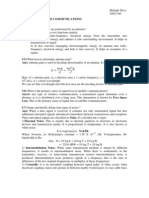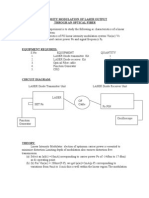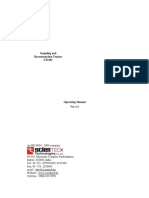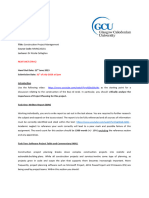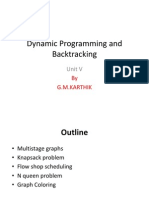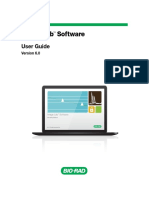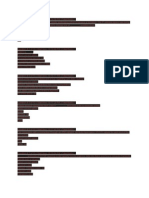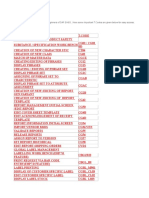DCOM Lab Manual
DCOM Lab Manual
Uploaded by
Gaurav KalraCopyright:
Available Formats
DCOM Lab Manual
DCOM Lab Manual
Uploaded by
Gaurav KalraOriginal Description:
Original Title
Copyright
Available Formats
Share this document
Did you find this document useful?
Is this content inappropriate?
Copyright:
Available Formats
DCOM Lab Manual
DCOM Lab Manual
Uploaded by
Gaurav KalraCopyright:
Available Formats
DIGITAL COMMUNICATION 2019
EXPERIMENT NO. 1
AIM: Study of Sampling theorem and Reconstruction of signal. Verify Nyquist criteria.
APPARATUS: Model ST 2151 trainer kit, connection wires, DSO, Power supply.
THEORY: The signals we use in the real world, such as our voice, are called "analog" signals.
To process these signals for digital communication, we need to convert analog signals to
"digital" form. While an analog signal is continuous in both time and amplitude, a digital signal
is discrete in both time and amplitude. To convert continuous time signal to discrete time signal,
a process is used called as sampling. The value of the signal is measured at certain intervals in
time. Each measurement is referred to as a sample.
In electronics, a sample and hold circuit is used to interface real world, changing analogue
signals to a subsequent system such as an analog-to-digital converter. The purpose of this
circuit is to hold the analogue value steady for a short time while the converter or other
following system performs some operation that takes a little time. In most circuits, a capacitor
is used to store the analogue voltage and an electronic switch or gate is used to alternately
connect and disconnect the capacitor from the analogue input. The rate at which this switch is
operated is the sampling rate of the system.
NYQUIST CRITERION (SAMPLING THEOREM):
The Nyquist Criterion states that a continuous signal band limited to fm Hz can be completely
represented by and reconstructed from the samples taken at a rate greater than or equal to 2fm
samples/second. The minimum sampling frequency is called as NYQUIST RATE i.e. for
faithful reproduction.
SAMPLE AND HOLD:
One way to maintain reasonable pulse energy is to hold the sample value until the next sample
is taken. This technique is formed as Sample and Hold technique. A buffered Sample and Hold
circuit consists of unity gain buffers preceding and succeeding the charging capacitor. The high
input impedance of the proceeding buffer prevents the loading of the message source and also
ensures that the capacitor charges by a constant rate irrespective of the source impedance.
S.V.N.I.T, SURAT Page 1
DIGITAL COMMUNICATION 2019
Procedure:
1. Connect the power cord to the trainer. Keep the power switch in ‘Off’ position.
2. Connect 1 KHz Sine wave to signal Input.
3. Connect BNC connector to the DSO and to the trainer’s output port.
4. Connect Sample Output to fourth order low pass filter Input and Sample and hold Output
to second order low pass filter Input. Observe the output wave form.
5. Switch ‘On’ the trainer's power supply & Oscilloscope.
6. By pressing Sampling Frequency Selector Switch, change the sampling frequency from 2
KHz, 5 KHz, 10 KHz, 20 KHz up to 40 KHz.
7. Observe how Sample output and Sample and Hold Output changes in each case.
8. Also observe output of second order low pass filter and fourth order low pass filter.
S.V.N.I.T, SURAT Page 2
DIGITAL COMMUNICATION 2019
Observation:
Input Carrier Sampled LPF 2nd LPF 4th Sampled LPF 2nd LPF 4th
Signal Frequency Output Order Order and Hold Order Order
(Sampled) (Sampled) Output (Sample & (Sample &
Hold) Hold)
3.60 Vpp 4.1Vpp 8 KHz 3.24 Vpp 2.16 Vpp 408 mVpp 3.60 Vpp 3.76 Vpp 864 mVpp
1KHz
INPUT WAVEFORM:
SAMPLED OUTPUT:
2nd ORDER LPF OUTPUT(SAMPLED) : 4 TH ORDER LPF OUTPUT(SAMPLED):
S.V.N.I.T, SURAT Page 3
DIGITAL COMMUNICATION 2019
SAMPLE AND HOLD OUTPUT:
2nd ORDER LPF OUTPUT(SAMPLED & HOLD) : 4 TH ORDER LPF OUTPUT(SAMPLED & HOLD):
Conclusion:
S.V.N.I.T, SURAT Page 4
DIGITAL COMMUNICATION 2019
EXPERIMENT NO. 2
AIM: To study the PAM (Pulse Amplitude Modulation), PWM (Pulse Width Modulation)
& PPM (Pulse Position Modulation) of analog signal.
APPARATUS: Connecting Probes, DSO, PAM-PWM-PPM Modulation Kit.
THEORY: The aim of pulse modulation methods is to transfer a narrowband analog signal,
for example a phone call over a wideband baseband channel or, in some of the schemes, as a
bit stream over another digital transmission system.
Pulse Amplitude Modulation (PAM):
In pulse amplitude modulation system the amplitude of the pulse is varied in accordance with
the instantaneous level of the modulating signal. Pulse-amplitude modulation (PAM), is a form
of signal modulation where the message information is encoded in the amplitude of a series of
signal pulses. It is an analog pulse modulation scheme in which the amplitudes of a train of
carrier pulses are varied according to the sample value of the message signal. Demodulation is
performed by detecting the amplitude level of the carrier at every symbol period.
Pulse Width Modulation (PWM):
Pulse-width modulation (PWM), or pulse-duration modulation (PDM), is a modulation
technique that controls the width of the pulse, formally the pulse duration, based on modulator
signal information. Although this modulation technique can be used to encode information for
transmission, its main use is to allow the control of the power supplied to electrical devices,
especially to inertial loads such as motors. In addition, PWM is one of the two principal
algorithms used in photovoltaic solar battery chargers.
Pulse Position Modulation (PPM):
In PPM System, the position of the pulse relative to the zero reference level is varied in
accordance with the instantaneous level of the modulating signal. Pulse Position Modulation
(PPM) differs from PWM in that the value of each instantaneous sample of a modulating wave
is caused to vary the position in time of a pulse, relative to its non-modulated time of
occurrence. Each pulse has identical shape independent of the modulation depth. This is an
attractive feature, since a uniform pulse is simple to reproduce with a simple switching power
stage. On the other hand, a limitation of PPM is the requirements for pulse amplitude level if
reasonable powers are required. The power supply level of the switching power stage will have
to be much higher than the required load voltage. This leads to sub-optimal performance on
several parameters as efficiency, complexity and audio performance.
S.V.N.I.T, SURAT Page 5
DIGITAL COMMUNICATION 2019
Figure: Different types of Pulse Modulation
Figure: PAM, PPM and PWM Trainer Kit
S.V.N.I.T, SURAT Page 6
DIGITAL COMMUNICATION 2019
PROCEDURE:
1. Connect the power cord to the trainer. Keep the power switch in ‘Off’ position.
2. Connect 1 KHz Sine wave to signal Input.
3. Connect BNC connector to the DSO and to the trainer’s output port.
4. Connect the high frequency pulses as carrier frequency to the pulse input of the kit. The
pulse trains are available in the range of 4KHz, 8KHz, 16 KHz and 64 KHz.
5. Switch ‘On’ the trainer's power supply & Oscilloscope.
6. Observe the output waveform at the DSO and compare the change in waveform with
respect to the input sine wave.
7. Now connect the output of the pulse modulation to the input of Low Pass Filter.
8. Connect the output of the Low Pass Filter to the AC amplifier.
9. Observe the output of the AC amplifier to the DSO and compare the demodulated signal
with respect to the input sine wave.
OBSERVATIONS:
CONCLUSION:
S.V.N.I.T, SURAT Page 7
DIGITAL COMMUNICATION 2019
EXPERIMENT NO. 3
AIM: To write a MATLAB program to sample the sinusoidal message signal at different
sampling rate and verify the Nyquist criteria. Also reconstruct the sampled signal using
low pass filter (Using FDA Tools).
APPARATUS: MATLAB Software
THEORY:
Sampling: Sampling is the process in which a continuous time signal is sampled by measuring
its amplitude at discrete instants.
Sampling Theorem: The Sampling Theorem states that a signal whose spectrum is band-
limited to Fm Hz can be reconstructed exactly (without error) from its samples taken uniformly
at a frequency Fs ≥ 2Fm (Samples per second).
In other words, the minimum sampling frequency is Fs = 2·Fm.
The frequency 2· Fm is called the Nyquist sampling rate.
The corresponding sampling interval Ts = 1/(Fs) is called Nyquist interval.
S.V.N.I.T, SURAT Page 8
DIGITAL COMMUNICATION 2019
MATLAB Code:
clc
clear all
close all
%message signal
t=0:0.01:2
f=1
x=sin(2*pi*f*t)
subplot(421)
plot(t,x)
xlabel('Time')
ylabel('Amplitude')
title('message signal')
%perfectly sampled
fs1=2*f
t1=0:0.1/fs1:2
x1=sin(2*pi*f*t1)
subplot(423)
stem(t1,x1)
xlabel('Time')
ylabel('Amplitude')
title('perfectly sampled')
%over sampled
fs2=5*f
t2=0:0.1/fs2:2
x2=sin(2*pi*f*t2)
subplot(425)
stem(t2,x2)
xlabel('Time')
ylabel('Amplitude')
title('over sampled')
%under sampled
fs3=0.8*f
t3=0:0.1/fs3:2
x3=sin(2*pi*f*t3)
subplot(427)
stem(t3,x3)
xlabel('Time')
ylabel('Amplitude')
title('under sampled')
%recontructed from perfectly sampled
y1 = filter(f,1,x1)
subplot(424)
plot(t1,y1)
xlabel('Time')
ylabel('Amplitude')
title('recontructed from perfectly sampled')
%recontructed from over sampled
y2 = filter(f,1,x2)
subplot(426)
plot(t2,y2)
xlabel('Time')
ylabel('Amplitude')
title('recontructed from over sampled')
S.V.N.I.T, SURAT Page 9
DIGITAL COMMUNICATION 2019
%recontructed from under sampled
y3 = filter(f,1,x3)
subplot(428)
plot(t3,y3)
xlabel('Time')
ylabel('Amplitude')
title('recontructed from under sampled')
Output Waveforms:
CONCLUSION
S.V.N.I.T, SURAT Page 10
DIGITAL COMMUNICATION 2019
EXPERIMENT NO: 4
AIM: To study Pulse Code Modulation (PCM), its demodulation and its application in
Time Division Multiplexing (TDM).
APPARATUS: TDM Pulse code modulator & transmitter (ST2153), TDM Pulse code
Demodulator & receiver (ST2154), DSO, testing probes, connecting wires
THEORY:
Pulse-code modulation (PCM) is a method used to digitally represent sampled analog signals.
Analog voice data must be translated into a series of binary digits before they can be transmitted.
With PCM, the amplitude of the wave to be transmitted is sampled at regular intervals and
translated into a binary number.
Sampling and quantization of a signal for 4-bit PCM
Time Division Multiplexing (TDM) is a type of digital (or rarely analog) multiplexing in
which switching takes place between two or more signals (mostly PCM signals), serially in
time. In this the time domain is divided into several recurrent time slots of fixed length, one for
each sub-channel.
S.V.N.I.T, SURAT Page 11
DIGITAL COMMUNICATION 2019
Procedure:
1. Set the initial conditions on both the kits.
2. Make connections as shown in Figure 1.1 as follows:
ON ST2153:
a) ~2 KHz Signal to CH.I Input.
b) ~4 KHz Signal to CH.II Input.
Between ST2153 & ST2154
ST 2153 ST 2154
Tx. Clock output Rx. Clock input
Tx. TO output Rx. TO input
PCM output PCM data input
3. Set the 7- bit pattern for A/D conversion. Observe that the same set of data should be there
for D/A conversion.
4. Vary DC signal (I) and note that the LED's on the A/D converter block on ST2153 & D/A
converter of ST2154 always carries the same code. If you desire to examine the timing of
data flow & control signal in detail, switch the transmitter & receiver into SLOW mode.
5. Observe the two output waveforms at TDM PCM Receiver's CH.I (TP47) & CH.II (TP50)
outputs are distortion less & also observe the LED's in the error check code detector block
are 'OFF'.
6. The errors in the system can be introduced with the help of fault switches given on the
techbook.
S.V.N.I.T, SURAT Page 12
DIGITAL COMMUNICATION 2019
Figure 1.1 Connection diagram for PCM
OBSERVATIONS:
S.V.N.I.T, SURAT Page 13
DIGITAL COMMUNICATION 2019
CONCLUSION:
S.V.N.I.T, SURAT Page 14
DIGITAL COMMUNICATION 2019
EXPERIMENT NO: 5
AIM: To study the Modulation and Demodulation of signal using Pulse Code Modulation on
MATLAB software.
APPARATUS: MATLAB Software
MATLAB CODE:
clc;
clear;
close;
%Input Singal
fm = 1;
fs = 2*fm;
t = -2:0.1:2;
x = 2.*sin(2*pi*fm*t)+2;
subplot(411);
plot(t,x);
xlabel('Time');
ylabel('Amplitude');
title('Original Signal');
%Sampling of the input signal
t1 = -2:0.1/fs:2;
y = 2.*sin(2*pi*(fm)*t1)+2;
subplot(412);
stem(y);
xlabel('Time');
ylabel('Amplitude');
title('Sampled Signal');
%Quantization of sampled signal
quant = floor(1.3*y);
subplot(413);
plot(t1,quant);
xlabel('Time');
ylabel('Amplitude');
title('Quantized Signal');
%Encoding
enc = dec2bin(quant);
%Decoding
dec = bin2dec(enc);
%Interpolation
interp = interp1(t1,dec,t,'spline');
subplot(414);
plot(t,interp);
xlabel('Time');
ylabel('Amplitude');
title('Reconstructed Signal');
S.V.N.I.T, SURAT Page 15
DIGITAL COMMUNICATION 2019
OBSERVATIONS:
CONCLUSION:
S.V.N.I.T, SURAT Page 16
DIGITAL COMMUNICATION 2019
EXPERIMENT NO:6
AIM: To study and observe the performance of Return to Zero (RZ) and Non Return to
Zero (NRZ) types of Line Coding.
APPARATUS: Testing probes, DSO, connecting probes, Data formation and transmitter
carrier modulation kit (ST2156)
THEORY:
Line coding consists of representing the digital signal to be transported by an amplitude- and
time-discrete signal that is optimally tuned for the specific properties of the physical channel
(and of the receiving equipment). The waveform pattern of voltage or current used to represent
the 1s and 0s of a digital data on a transmission link is called line encoding. The common types
of line encoding are unipolar, polar, bipolar, and encoding. Line codes are used commonly in
computer communication networks over short distances. Each of the various line formats has
a particular advantage and disadvantage. It is not possible to select one, which will meet all
needs. The format may be selected to meet one or more of the following criteria:
Minimize transmission hardware
Facilitate synchronization
Ease error detection and correction
Minimize spectral content
Eliminate a dc component
The Manchester code is quite popular. It is known as a self-clocking code because there is
always a transition during the bit interval. Consequently, long strings of zeros or ones do not
cause clocking problems.
Figure 1.1 Classification of Line Codes
S.V.N.I.T, SURAT Page 17
DIGITAL COMMUNICATION 2019
Figure 1.2 Various Data formatting techniques
1. Non-Return-to-Zero Code
The non-return-to-zero (NRZ) format is the prototypical representation of binary data: A
logical zero state is transmitted as one signal level, and a logical one state as another level.
Levels change at bit boundaries only if the bit value changes and remain stable for the entire
duration of the bit period. If the level representing the zero logical bit state is lower than the
level for the one state, we call this positive logic, and the respective levels are then called low
level and high level. NRZ signals always have a clock signal associated with them, even if it is
not transmitted along with the data. Figure 1.3 shows the NRZ representation of a short data
sequence, together with a clock signal.
Figure 1.3 NRZ Waveforms
2. Return-to-Zero Code
The return-to-zero (RZ) code represents the zero logical state as a static low level and the one
state as a short high-level pulse. The signal always returns to the level representing a zero state
immediately after the high level, hence the name. RZ signals can be easily created from NRZ
signals, by a binary AND of the NRZ and a clock. The width of the pulses depends on the duty
cycle of the clock. Figure 1.4 shows the RZ representation of a short data sequence.
S.V.N.I.T, SURAT Page 18
DIGITAL COMMUNICATION 2019
Figure 1.4 RZ Waveforms
3. (Biphase) Manchester
Manchester code is generated from NRZ data by a binary XOR with a clock signal. Since there
are two possible clock phases, there are also two variants of Manchester code. The coded data
has a transition in the middle of every bit, and the direction of this transition indicates a binary
zero or one. The original Manchester variant uses a falling edge for a one and a rising edge for
a zero; the other variant is the exact inverse. Figure 1.5 Shown the Manchester code.
Figure 1.5 Manchester Waveforms
4. Biphase (Mark):
For any bit either 1 or 0, first half bit duration +5V or 0V and invert of first half during next
half bit duration. Bit 0 Bit Pattern remains the same.
Figure 1.6 Mark Waveforms
5. Return to Bias (RB):
During the first half a period, positive level for bit 1 and a negative level for bit 0 and during
the second half bit time, both returns to the bias level.
S.V.N.I.T, SURAT Page 19
DIGITAL COMMUNICATION 2019
Figure 1.7 RB Waveforms
6. Alternate Mark Inversion
Like RB encoding, the AMI always returns to the bias level during second half of the bit time
interval and during the first half the transmitted level can be a positive, a negative or bias
level, as for a bit 0 bias level and for a bit 1 either a positive level or negative level, the level
being chose opposite to what it was used to represent the previous bit 1.
Figure 1.8 AMI Waveforms
PROCEDURE:
1. Connect the power supplies of ST2156 and ST2157 but do not turn on the power supplies
until connections are made for this experiment.
2. Make the connections as shown in the figure.
3. Switch 'ON' the power.
4. On ST2156, connect oscilloscope CH1 to ‘Clock In’ and CH2 to ‘Data In’ and observe the
waveforms.
5. Connect oscilloscope CH1 to ‘Data In’ and CH2 to ‘NRZ (L)’ and observe the waveforms.
6. Connect oscilloscope CH1 to ‘Data In’ and CH2 to ‘NRZ (M)’ and observe the waveforms.
7. Connect oscilloscope CH1 to ‘Data In’ and CH2 to ‘RZ’ and observe the waveforms.
8. Connect oscilloscope CH1 to ‘Data In’ and CH2 to ‘Biphase (manchester)’ and observe the
waveforms.
9. Connect oscilloscope CH1 to ‘Data In’ and CH2 to ‘Biphase (Mark)’ and observe the
waveforms.
10. Connect oscilloscope CH1 to ‘Data In’ and CH2 to ‘RB’ and observe the waveforms.
11. Connect oscilloscope CH1 to ‘Data In’ and CH2 to ‘AMI’ and observe the waveforms.
S.V.N.I.T, SURAT Page 20
DIGITAL COMMUNICATION 2019
OBSERVATION:
CONCLUSION:
S.V.N.I.T, SURAT Page 21
DIGITAL COMMUNICATION 2019
EXPERIMENT NO: 7
AIM: To perform the Delta and Adaptive delta Modulation and Demodulation technique
on Experiment kit and observe various outputs using DSO.
APPARATUS: Connecting Probes, DSO, Delta and Adaptive Delta Modulation Kit.
THEORY:
Delta modulator technique has evolved a simple, efficient method for digitizing input signal
for secure, reliable communications and for voice input- output in data processing.
What is Delta Modulator?
Delta modulator (DM or Δ-modulation) is an analog-to-digital and digital-to analog signal
conversion technique used for transmission of voice information where quality is not of
primary importance. DM is the simplest form of differential pulse-code modulation (DPCM)
where the difference between successive samples is encoded into n-bit data streams. In delta
modulation, the transmitted data is reduced to a 1-bit data stream.
The modulator is a sampled data system employing a feedback loop. A comparator senses
whether or not the instantaneous level of the analog input is greater or less than the feedback
signal. The comparator output is clocked by a flip-flop to form a continuous NRZ digital data
stream. This digital data is also integrated and feedback to the comparator. The feedback
system is such that the integrator ramps up and down to produce a rough approximation of the
input waveform. One can see that the digital data 0’s and 1’s are command to the integrators
to “go up” or “go down” respectively. Delta Modulation attempts to represent an analog signal
with a resolution of 1 bit. This is accomplished by successive steps, either up or down, by a
preset step size. In delta modulation, we have the step size (Δ) that is defined for each sampler,
and we have the following rules for output:
i) If the input signal is higher than the current reference signal, increase the reference
by Δ, and output a 1.
ii) If the input signal is lower than the current reference signal, decrease the reference
by Δ, and output a 0.
Delta demodulator is a simple integrator and as the logic 1s and 0s are received, the up-down
counter is incremented or decremented accordingly.
S.V.N.I.T, SURAT Page 22
DIGITAL COMMUNICATION 2019
Adaptive delta modulator technique has evolved a simple, efficient method for digitizing input
signal for secure, reliable communications and for voice input- output in data processing.
What is Adaptive Delta Modulator?
Delta modulation is an important modulation technique employed for data communication.
Since slope overload error is a big problem in delta modulation, adaptive delta modulation
became more important.
Working: A simple block diagram of the ADM is shown in Fig. The accumulator generates a
data based on the past ADM pulses transmitted, which would always try to approach the given
analog signal. The sampled form of the analog signal and the analog equivalent of the
accumulator are compared in an analog comparator C and the present ADM pulses are
produced. The step generator produces the new step at every clock. The proposed algorithm
for generating the step size can be stated as follows. When the accumulated signal doesn’t cross
the analog signal in the comparator, the step size is doubled so that it would catch the input
analog signal quickly and when once it crosses it, the step size is made as half the previous step
and not made unity step. If there is another crossover by the next clock the step again reduces
to half of the previous value. Nevertheless, the minimum step size that can be reached is kept
as unity. If the accumulated signal is continuously above (or below) the given analog input
signal the step size doubles every time and it is made as half of the previous step after reaching
three consecutive increase in step size and thereafter the step doubling process would continue.
S.V.N.I.T, SURAT Page 23
DIGITAL COMMUNICATION 2019
Adaptive Delta Demodulator:
The ADM demodulator has somewhat similar function as modulator. The receiver also follows
the same algorithm as that of the transmitter and the accumulator at the receiver at any time
would build the same pattern of signal generated by the accumulator of the transmitter. The
received ADM pulses are given to the SP register and used as the instantaneous command for
the ADD/SUB input of the 8AS. If this is of logic ‘1’ it adds up the STR register to the
accumulator (AC) otherwise it would subtract it from the AC.
OBSERVATIONS:
S.V.N.I.T, SURAT Page 24
DIGITAL COMMUNICATION 2019
CONCLUSION:
S.V.N.I.T, SURAT Page 25
DIGITAL COMMUNICATION 2019
EXPERIMENT NO:8
AIM: To study Modulation and Demodulation of digital signal using ASK (Amplitude
Shift Keying), FSK (Frequency Shift Keying), PSK (Phase Shift Keying).
APPARATUS: Testing probes, DSO, connecting probes, Data formation and transmitter
carrier modulation kit (ST2156), Digital communication trainer (ST2157).
THEORY:
ASK: Amplitude-shift keying is a form of modulation that represents digital data as variations
in the amplitude of a carrier wave. Frequency and phase of the carrier are kept constant. The
demodulator, which is designed specifically for the symbol-set used by the modulator,
determines the amplitude of the received signal and maps it back to the symbol it represents.
Circuit Diagram:
Procedure:
1. Connect the power supplies of ST2156 and ST2157 but do not turn on the power supplies
until connections are made for this experiment.
2. Make the connections as shown in the figure.
3. Switch 'ON' the power.
4. On ST2156, connect oscilloscope CH1 to ‘Clock In’ and CH2 to ‘Data In’ and observe the
waveforms.
5. On ST2156, connect oscilloscope CH1 to ‘NRZ (L)’ and CH2 to ‘Output’ of modulator
Circuit (l) on ST2156 and observe the waveforms.
6. Vary the gain potentiometer of modulator circuit (l) on ST2156 to adjust the amplitude of
ASK Waveform.
7. On ST2156, connect oscilloscope CH1 to ‘NRZ (L)’ and CH2 to ‘Output’ of comparator
on ST2157 and observe the waveforms.
S.V.N.I.T, SURAT Page 26
DIGITAL COMMUNICATION 2019
FSK: Frequency-shift keying is a frequency modulation scheme in which digital information
is transmitted through discrete frequency changes of a carrier wave. Amplitude and phase of
the carrier are kept constant. Modulator uses two carrier waves of different frequencies so as
to represent different levels of digital signal. The demodulator, which is designed specifically
for the symbol-set used by the modulator, determines the different frequency of the received
signal and maps it back to the symbol it represents.
Circuit Diagram:
S.V.N.I.T, SURAT Page 27
DIGITAL COMMUNICATION 2019
Procedure:
1. Connect the power supplies of ST2156 and ST2157 but do not turn on the power supplies
until connections are made for this experiment.
2. Make the connections as shown in the figure 3.1.
3. Switch 'ON' the power.
4. On ST2156, connect oscilloscope CH1 to ‘Clock In’ and CH2 to ‘Data In’ and observe the
waveforms.
5. On ST2156, connect oscilloscope CH1 to ‘NRZ (L)’ and CH2 to ‘Output’ of Summing
Amplifier on ST2156 and observe the waveforms.
6. Adjust the potentiometers of both the Modulator Circuit (l) & (ll) onST2156 to adjust the
amplitude of FSK waveform at Summing Amplifier’s output on ST2156.
7. On ST2156, connect oscilloscope CH1 to ‘NRZ (L)’ and CH2 to ‘Output’ of comparator
on ST2157 and observe the waveforms.
S.V.N.I.T, SURAT Page 28
DIGITAL COMMUNICATION 2019
PSK: Phase-shift keying is a digital modulation scheme that conveys data by changing, or
modulating, the phase of a reference signal (the carrier wave). The demodulator, which is
designed specifically for the symbol-set used by the modulator, determines the phase of the
received signal and maps it back to the symbol it represents.
Circuit Diagram:
1. Procedure:
1. Connect the power supplies of ST2156 and ST2157 but do not turn on the power supplies
until connections are made for this experiment.
2. Make the connections as shown in the figure 4.1.
3. Switch 'ON' the power.
4. On ST2156, connect oscilloscope CH1 to ‘Clock In’ and CH2 to ‘Data In’ and observe the
waveforms.
5. On ST2156, connect oscilloscope CH1 to ‘NRZ (L)’ and CH2 to ‘Output’ of Modulator
Circuit (l) on ST2156 and observe the waveforms.
6. Adjust the ‘Gain’ potentiometer of the Modulator Circuit (l) on ST2156 to adjust the
amplitude of PSK waveform at output of Modulator Circuit (l) on ST2156.
7. Now on ST2157 connect oscilloscope CH1 to ‘Input’ of PSK demodulator and connect
CH2 one by one to output of double squaring circuit, output of PLL, output of Divide by
four (÷ 2) observe the wave forms.
8. On ST2157 connect oscilloscope CH1 to output of Phase adjust and CH2 to ‘output’ of
PSK demodulator and observe the waveforms. Set all toggle switch to 0 and compare the
waveform now vary the phase adjust potentiometer and observe its effects on the
demodulated signal waveform. (Note: If there is problem in setting the waveform with
potentiometer then toggle the switch given in PSK demodulator block two to three times to
get the required waveform).
9. Now connect oscilloscope CH1 to ‘PSK’ output of PSK demodulator on ST2157 and
connect CH2 ‘Output’ of Low Pass Filter on ST2157 and observe the waveforms.
10. Connect oscilloscope CH1 to ‘Output’ of Low Pass Filter on ST2157 then connect CH2 to
‘Output’ of Comparator on ST2157 and observe the waveforms, now vary the reference
voltage potentiometer of first comparator to generate desired data pattern.
11. On ST2156, connect oscilloscope CH1 to ‘NRZ (L)’ and CH2 to ‘Output’ of comparator
on ST2157 and observe the waveforms.
S.V.N.I.T, SURAT Page 29
DIGITAL COMMUNICATION 2019
12. Connect oscilloscope CH1 to ‘Data In’ then connect CH2 output to Bit decoder and observe
the waveforms. If both data does not matches then try to match it by varying the phase
adjust potentiometer on QPSK Demodulator.
13. Now try to match the LED sequence by once pressing the reset switch on ST2156.
OBSERVATIONS:
CONCLUSION:
S.V.N.I.T, SURAT Page 30
DIGITAL COMMUNICATION 2019
EXPERIMENT NO: 9
AIM: To study the Raised Cosine Filter in time domain as well as in frequency domain
using MATLAB software.
Apparatus: MATLAB software.
THEORY:
Raised Cosine Filter
A raised cosine filter is a low-pass filter which is commonly used for pulse shaping in data
transmission systems (e.g. modems). The frequency response |H(f)| of a perfect raised cosine
filter is symmetrical about 0 Hz, and is divided into three parts : it is flat (constant) in the pass-
band; it sinks in a graceful cosine curve to zero through the transition region; and it is zero
outside the pass-band. The response of a real filter is an approximation to this behaviour.
The equations which defined the filter contain a parameter ``beta'', which is known as the roll-
off factor or the excess bandwidth. ``beta'' lies between 0 and 1.
A family of spectra that satisfy the Nyquist Theorem is the raised cosine family whose spectra
are
f is the frequency.
T is the symbol time.
beta is the rolloff factor.
Where the parameter roll-off factor beta is a real number on the interval 0≤ β ≤1that
determines the bandwidth of the spectrum.
BW= (1+ β)/Ts = (1+ β) Rs
The corresponding time domain signal is
t is the time.
T is the symbol time.
beta is the rolloff factor.
S.V.N.I.T, SURAT Page 31
DIGITAL COMMUNICATION 2019
Figure : Raised Cosine Filter Characteristics for various values of Beta
MATLAB CODE :
S.V.N.I.T, SURAT Page 32
DIGITAL COMMUNICATION 2019
S.V.N.I.T, SURAT Page 33
DIGITAL COMMUNICATION 2019
OBSERVATIONS:
CONCLUSION:
S.V.N.I.T, SURAT Page 34
DIGITAL COMMUNICATION 2019
EXPERIMENT NO: 10
AIM: To study Modulation and Demodulation of signal using Quadrature Amplitude
Modulation and to study the Constellation diagram as well as Eye-diagram on MATLAB
software.
APPARATUS: MATLAB software.
Theory:
Quadrature Amplitude Modulation or QAM is a form of modulation which is widely used for
modulating data signals onto a carrier used for radio communications. It is widely used because
it offers advantages over other forms of data modulation such as PSK, although many forms of
data modulation operate alongside each other.
Quadrature Amplitude Modulation, QAM is a signal in which two carriers shifted in phase by
90 degrees are modulated and the resultant output consists of both amplitude and phase
variations. In view of the fact that both amplitude and phase variations are present it may also
be considered as a mixture of amplitude and phase modulation. A motivation for the use of
quadrature amplitude modulation comes from the fact that a straight amplitude modulated
signal, i.e. double sideband even with a suppressed carrier occupies twice the bandwidth of the
modulating signal. This is very wasteful of the available frequency spectrum. QAM restores
the balance by placing two independent double sideband suppressed carrier signals in the same
spectrum as one ordinary double sideband suppressed carrier signal.
Quadrature amplitude modulation, QAM, when used for digital transmission for radio
communications applications is able to carry higher data rates than ordinary amplitude
modulated schemes and phase modulated schemes. As with phase shift keying, etc., the number
of points at which the signal can rest, i.e. the number of points on the constellation is indicated
in the modulation format description, e.g. 16QAM uses a 16 point constellation.
When using QAM, the constellation points are normally arranged in a square grid with equal
vertical and horizontal spacing and as a result the most common forms of QAM use a
constellation with the number of points equal to a power of 2 i.e. 4, 16, 64 . . . . By using higher
order modulation formats, i.e. more points on the constellation, it is possible to transmit more
bits per symbol. However the points are closer together and they are therefore more susceptible
to noise and data errors. Normally a QAM constellation is square and therefore the most
common forms of QAM 16QAM, 64QAM and 256QAM.
The advantage of moving to the higher order formats is that there are more points within the
constellation and therefore it is possible to transmit more bits per symbol. The downside is that
the constellation points are closer together and therefore the link is more susceptible to noise.
As a result, higher order versions of QAM are only used when there is a sufficiently high signal
to noise ratio.
S.V.N.I.T, SURAT Page 35
DIGITAL COMMUNICATION 2019
Block Diagram:
Figure: Block Diagram of QAM Modulator and Demodulator
Constellation Diagram
A constellation diagram is a representation of a signal modulated by a digital modulation
scheme such as quadrature amplitude modulation or phase-shift keying. It displays the signal
as a two-dimensional scatter diagram in the complex plane at symbol sampling instants. In a
more abstract sense, it represents the possible symbols that may be selected by a given
modulation scheme as points in the complex plane. Measured constellation diagrams can be
used to recognize the type of interference and distortion in a signal.
Eye Diagram
In telecommunication, an eye pattern, also known as an eye diagram, is an oscilloscope display
in which a digital data signal from a receiver is repetitively sampled and applied to the vertical
input, while the data rate is used to trigger the horizontal sweep. It is so called because, for
several types of coding, the pattern looks like a series of eyes between a pair of rails. It is an
experimental tool for the evaluation of the combined effects of channel noise and Inter-symbol
interference on the performance of a baseband pulse-transmission system. It is the
synchronized superposition of all possible realizations of the signal of interest viewed within a
particular signaling interval.
S.V.N.I.T, SURAT Page 36
DIGITAL COMMUNICATION 2019
MATLAB CODE:
S.V.N.I.T, SURAT Page 37
DIGITAL COMMUNICATION 2019
OBSERVATIONS:
CONCLUSION:
S.V.N.I.T, SURAT Page 38
You might also like
- 6S 50 MC-C, Vol. III - Component, DescriptionDocument184 pages6S 50 MC-C, Vol. III - Component, DescriptionAbsar Mamun100% (8)
- Bruno Clerckx SlidesDocument60 pagesBruno Clerckx SlidesMehrdad SalNo ratings yet
- Adc Mod 4Document130 pagesAdc Mod 4anuNo ratings yet
- Dsplabmanual-By 22Document64 pagesDsplabmanual-By 22debasnan singh100% (1)
- To Understand The Handover MechanismDocument7 pagesTo Understand The Handover MechanismGaneshNo ratings yet
- Spectral Estimation NotesDocument6 pagesSpectral Estimation NotesSantanu Ghorai100% (1)
- Region Filling (RF & FF)Document3 pagesRegion Filling (RF & FF)Ansuman MahantyNo ratings yet
- Report of Comm. Sys. Project ASK, FSK & QAMDocument8 pagesReport of Comm. Sys. Project ASK, FSK & QAMMehryn JavedNo ratings yet
- Unit - II - ClassDocument86 pagesUnit - II - ClassFashid FasilNo ratings yet
- Unit - 5 - Multiple Antenna TechniquesDocument65 pagesUnit - 5 - Multiple Antenna TechniquesDORAIRAJ ADARSH Y UEC19132No ratings yet
- EC403 Analog CommunicationDocument53 pagesEC403 Analog CommunicationMnshNo ratings yet
- Advance Communication Lab-15ECL76Document39 pagesAdvance Communication Lab-15ECL76Pradeep kumarNo ratings yet
- CDMA MIMO and OFDM NPTEL NotesDocument9 pagesCDMA MIMO and OFDM NPTEL Notessridhar bodduNo ratings yet
- ME Communication Systems R 2007 SyllabusDocument27 pagesME Communication Systems R 2007 SyllabusKathiravan SrinivasanNo ratings yet
- Analogue and Digital Communication Lab ManualDocument95 pagesAnalogue and Digital Communication Lab ManualZara Zara100% (1)
- PSD Autocorrelation NoiseDocument7 pagesPSD Autocorrelation NoiseM MovNo ratings yet
- Ch02Document10 pagesCh02Victor Manuel Medina RamirezNo ratings yet
- Neural Semiconductor Limited: Digital VLSI Testing Lecture-2 (Introduction)Document15 pagesNeural Semiconductor Limited: Digital VLSI Testing Lecture-2 (Introduction)Anik PaulNo ratings yet
- SBH Mtech ReportDocument65 pagesSBH Mtech ReportAnkit NasreNo ratings yet
- Chroma Subsampling Numbers ExplainedDocument12 pagesChroma Subsampling Numbers ExplainedLaurentiu Iacob100% (1)
- Ofdm For Wireless Communications Systems PDFDocument2 pagesOfdm For Wireless Communications Systems PDFKatieNo ratings yet
- QPSK Mod&Demodwith NoiseDocument32 pagesQPSK Mod&Demodwith Noisemanaswini thogaruNo ratings yet
- Lecture 7 (Channel Models For Mmwave MIMO System)Document65 pagesLecture 7 (Channel Models For Mmwave MIMO System)Kushagra PratapNo ratings yet
- Experiment 6 Implementation of LP Fir Filter For A Given SequenceDocument25 pagesExperiment 6 Implementation of LP Fir Filter For A Given SequenceSrinivas SamalNo ratings yet
- Power Divider, Combiner and CouplerDocument60 pagesPower Divider, Combiner and Couplergaurav_juneja_4No ratings yet
- Digital Links: Point-to-Point LinksDocument3 pagesDigital Links: Point-to-Point LinksTisha KhatriNo ratings yet
- Lab - 3 Single - Stage MOSFET AmplifiersDocument11 pagesLab - 3 Single - Stage MOSFET AmplifiersMuhammad TehreemNo ratings yet
- Class Notes For MOSFETSDocument4 pagesClass Notes For MOSFETSCedric MontianoNo ratings yet
- Modulation Techniques For Mobile RadioDocument3 pagesModulation Techniques For Mobile RadioAbhinav50% (2)
- RC Delay Model Rise and Fall DelaysDocument24 pagesRC Delay Model Rise and Fall DelaysETHIO TECHNo ratings yet
- Communication Systems With SolutionsDocument109 pagesCommunication Systems With SolutionsChindam Hari Prasad50% (2)
- Types of NON-COCHANNEL INTERFERENCEDocument1 pageTypes of NON-COCHANNEL INTERFERENCEroyfadliNo ratings yet
- Matlab Interview Question AnswerDocument13 pagesMatlab Interview Question AnswerSumathi MaryNo ratings yet
- 2.1 Strip Lines3008221Document37 pages2.1 Strip Lines3008221Yash sutarNo ratings yet
- Lecture #11 Optical ReceiversDocument42 pagesLecture #11 Optical Receiversjeddo2005No ratings yet
- Digital Signal Processing Lab ManualDocument24 pagesDigital Signal Processing Lab ManualK Raghupathy VivekanandaNo ratings yet
- What Is GMSK ModulationDocument5 pagesWhat Is GMSK Modulationtrivedi_urvi9087No ratings yet
- Wirecomm hw2Document4 pagesWirecomm hw2Sravanthi MyneniNo ratings yet
- Project 14 - Transmission Line Design and Layout in ADS (October 2013)Document15 pagesProject 14 - Transmission Line Design and Layout in ADS (October 2013)Stephen J. WattNo ratings yet
- Antenna 2Document15 pagesAntenna 2Jaskirat Singh Chhabra100% (1)
- Electrical and Electronic Measuring InstrumentsDocument27 pagesElectrical and Electronic Measuring InstrumentsSaswat NayakNo ratings yet
- Intensity ModulationDocument3 pagesIntensity Modulationanon-323096100% (1)
- 3.PCM Theory and NumericalsDocument25 pages3.PCM Theory and NumericalsA47Sahil RahateNo ratings yet
- Television Engineering PDFDocument88 pagesTelevision Engineering PDFkrishkarnNo ratings yet
- Feedback AmplifierDocument52 pagesFeedback AmplifierBharavi K SNo ratings yet
- Multirate Signal Processing 1.4Document45 pagesMultirate Signal Processing 1.4criharshaNo ratings yet
- Chapter 2 - Signal Degradation in Optical FiberDocument28 pagesChapter 2 - Signal Degradation in Optical FiberNgay Tro VeNo ratings yet
- Lecture 04 - Signal Space Approach and Gram Schmidt ProcedureDocument20 pagesLecture 04 - Signal Space Approach and Gram Schmidt ProcedureKhoa PhamNo ratings yet
- ST2101Document34 pagesST2101sandeep_hot100% (1)
- DIGITAL COMMUNICATION Unit 2 VTU PDFDocument75 pagesDIGITAL COMMUNICATION Unit 2 VTU PDFHarsh Kapoor100% (1)
- ELEN443 Project II BPSK ModulationDocument18 pagesELEN443 Project II BPSK ModulationZiad El SamadNo ratings yet
- Experiment No.1 Rectangular Waveguide Design Using CST Microwave Studio SuiteDocument3 pagesExperiment No.1 Rectangular Waveguide Design Using CST Microwave Studio Suiteali saleh100% (2)
- Electrical Measurement BDocument10 pagesElectrical Measurement BAhmed Yousef SNo ratings yet
- Binary Erasure Channel (BEC)Document2 pagesBinary Erasure Channel (BEC)Anonymous JXTwISptYANo ratings yet
- Applications of MIMODocument2 pagesApplications of MIMOPriyadarshini GoreNo ratings yet
- Understanding UMTS Radio Network Modelling, Planning and Automated Optimisation: Theory and PracticeFrom EverandUnderstanding UMTS Radio Network Modelling, Planning and Automated Optimisation: Theory and PracticeMaciej NawrockiNo ratings yet
- DCOM Lab ManualDocument38 pagesDCOM Lab ManualGaurav KalraNo ratings yet
- DCOM Lab ManualDocument45 pagesDCOM Lab ManualSyeda InaasNo ratings yet
- MPI LabDocument4 pagesMPI LabGaurav KalraNo ratings yet
- Experiment: 6 Basic Functions Using Matlab: AIM: Design A 20Document3 pagesExperiment: 6 Basic Functions Using Matlab: AIM: Design A 20Gaurav KalraNo ratings yet
- Experiment: 6 Basic Functions Using Matlab: AIM: Design A 20Document3 pagesExperiment: 6 Basic Functions Using Matlab: AIM: Design A 20Gaurav KalraNo ratings yet
- DCOM Lab ManualDocument38 pagesDCOM Lab ManualGaurav KalraNo ratings yet
- Complexity of An AlgorithmDocument3 pagesComplexity of An Algorithmsayan.pal.23No ratings yet
- RM Young 61302 ManualDocument2 pagesRM Young 61302 ManualJimmy Calle GonzálezNo ratings yet
- MGT 615 Abridged SyllabusDocument2 pagesMGT 615 Abridged SyllabusVal SarateNo ratings yet
- Ba So Sap WH So Probolinggo 31052023Document2 pagesBa So Sap WH So Probolinggo 31052023Dimas OkasaNo ratings yet
- Zentyal Server 3 0 GuideDocument231 pagesZentyal Server 3 0 GuideSamir LNo ratings yet
- Z04 Rend6289 10 Im Mod4Document3 pagesZ04 Rend6289 10 Im Mod4José Manuel Orduño VillaNo ratings yet
- Extensible Storage Engine (ESE) Database File (EDB) FormatDocument53 pagesExtensible Storage Engine (ESE) Database File (EDB) FormatKali LNo ratings yet
- Allen-Bradley-Micrologix 1000 Programmable Controllers and Hand-Held ProgrammerDocument24 pagesAllen-Bradley-Micrologix 1000 Programmable Controllers and Hand-Held ProgrammerThe MatrixNo ratings yet
- Construction Project Management Resit CW2Document2 pagesConstruction Project Management Resit CW2sarfrazqadir098No ratings yet
- Dynamic Prgming & BacktrackingDocument98 pagesDynamic Prgming & Backtrackingharimano0% (1)
- 07490-12 Kundeninfo enDocument4 pages07490-12 Kundeninfo enManigandan DhamodhiranNo ratings yet
- ISTQTB BH0 010 Study MaterialDocument68 pagesISTQTB BH0 010 Study MaterialiuliaibNo ratings yet
- QY20Document48 pagesQY20Bao Hoang NguyenNo ratings yet
- Nitro Pro 7 User GuideDocument156 pagesNitro Pro 7 User GuideShruti ChohanNo ratings yet
- Module 1Document10 pagesModule 1ronin31stNo ratings yet
- Geometric SequenceDocument35 pagesGeometric SequenceMia Isabel BalaneNo ratings yet
- Image Lab Software: User GuideDocument212 pagesImage Lab Software: User GuideJKayckeNo ratings yet
- Home Theatre RCA RTD152 Service ManualDocument55 pagesHome Theatre RCA RTD152 Service ManualtcggoulartNo ratings yet
- CV Julie Verbert enDocument1 pageCV Julie Verbert enJulie VerbertNo ratings yet
- I22 0554 AliHashim Lab9Document1 pageI22 0554 AliHashim Lab9i220554 Syed MuhammadNo ratings yet
- Quiz cs610 3Document14 pagesQuiz cs610 3Malik Aatish100% (1)
- Chapter 13 IMCDocument21 pagesChapter 13 IMCAndrea NovillasNo ratings yet
- Osilama Paul, Paper - TukeyDocument14 pagesOsilama Paul, Paper - Tukeywofuru innocentNo ratings yet
- Release Notes Aerith Sephiroth Windows Driver - 2309131113Document18 pagesRelease Notes Aerith Sephiroth Windows Driver - 2309131113nnplaygroundnnNo ratings yet
- Avaya Access Faqs: 1. Getting Started: Login and RegistrationDocument8 pagesAvaya Access Faqs: 1. Getting Started: Login and RegistrationEnamul HaqNo ratings yet
- Chapter 7 Critical Thinking QuestionsDocument2 pagesChapter 7 Critical Thinking Questionsアイカの 彼氏No ratings yet
- Sap EhsDocument4 pagesSap EhsAdarsh KumarNo ratings yet
- LT08Document5 pagesLT08Jiya AliNo ratings yet
- Presentation of Time Management Skills - by SaraDocument48 pagesPresentation of Time Management Skills - by SaraSarah Hijazi100% (1)

